Rainbow

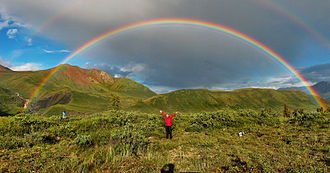





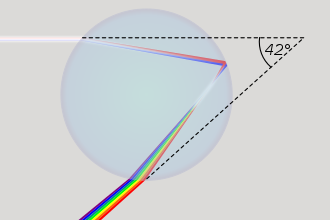

The rainbow is an meteorological atmospheric-optical phenomenon that appears as a luminous circular arc-shaped band shining in the seven colours of the rainbow in the sky when the observer looks at a wall of rain with the sun behind him. In addition to this primary rainbow, a paler secondary rainbow with a reversed colour sequence is often visible.
Rainbow colours
The colour sequence of this primary rainbow begins internally with violet, which then lightens (via indigo) to blue; green appears in the middle of the colour band, changing to yellow, orange and red towards the outside. The colour zones are not sharply delineated from each other, but more or less glide inside each other. The bright circular disc inside the colour fringe appears brighter than the sky outside and is a pale, somewhat blurred image of the sun. After a broader dark transition zone, which is an image of the rain-covered sky and is called Alexander's dark band after its discoverer, the ancient philosopher Alexander of Aphrodisias, a secondary rainbow, which is not always clearly visible, with a reversed colour sequence, connects to the outside. Outside the broad dark zone, the sky appears somewhat brighter again. From a physical point of view, the raindrops act like small prisms which cause colour fringes at the border between the bright image of the solar disk and the dark image of the surrounding sky. Reflection inside the raindrops causes the image of this colour-fringed border to be reflected back into the observer's eye at an angle of about 42°. This makes the primary rainbow visible. By reflecting twice in the drops, the corresponding much weaker secondary rainbow is reflected back to the observer at an angle of about 51°.
„You know the ordinary rainbow. The rainbow has a red band, then that changes to orange and yellow, then the band becomes green, then blue, then the band becomes a slightly darker blue, indigo blue and then the band becomes violet. So we get a number of seven colours approximately that the rainbow has in itself (see plate 6 drawing). Of course, people have always observed these seven colours and explained them in various ways, because actually these seven colours that you get from the rainbow are the most beautiful colours that you can see in nature.
And besides, you must know that these colours are as if they were floating freely. They are created, as you know, when the Sun is shining somewhere and there is rain in front of the Sun. Then the rainbow appears on the other side of the sky. So when you see a rainbow somewhere, you have to say: Where is the weather now? Yes, on the opposite side, on the side facing away from the rain, must be the Sun. - That is how the order must be. That is how these seven colours of the rainbow come into being.“ (Lit.:GA 350, p. 70f)
Primary and secondary rainbow form a whole
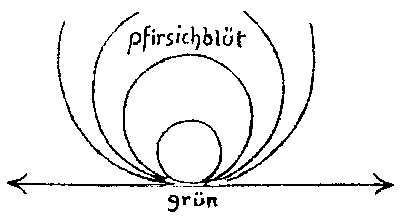
„But if we consider the whole spectrum, the whole field of colour phenomena, we can think of this spectrum as being formed from the really complete series of the twelve colours, which can only be characterised on a circle which has green at the bottom, peach blossom at the top and the other colours in between. And we can imagine that this circle now enlarges more and more; that peach blossom is lost to us here towards the top, and on the one hand runs here towards the red, on the other towards the violet, and beyond both. So in the ordinary spectrum we actually have a part of what would be there if the completeness of the colours could appear through the world of appearance surrounding man. We have only a part of it.
Now there is something that is most curious. I believe that if you take the usual descriptions of optics in physics books and move on to what is usually given there as an explanation of a special spectral phenomenon, namely the rainbow, you will feel a little uneasy if you like to stick to clear concepts. For the explanations of the rainbow are really given in such a way that one is left without a bow. One is compelled to take refuge in the raindrop and to follow all kinds of paths of the rays of light inside the raindrop, and one is then compelled to assemble this rather uniform picture of the rainbow from all kinds of little pictures which are still particularly dependent on the way in which one stands to it, pictures which actually arise through raindrops. In short, you have in these explanations something of an atomistic conception of an appearance that acts rather as a unity in our environment. But we can become even more uncomfortable than with the rainbow, that is, with the spectrum that nature itself conjures up before us, when we realise that this rainbow of which we speak never actually appears alone. No matter how much it is hidden, there is always a second rainbow. And what belongs together cannot be kept apart. The two rainbows, one of which is only more indistinct than the other, necessarily belong together, and in the field of explanations for the emergence of the rainbow one must not even attempt to explain only the one colour stripe, but one must be clear about the fact that the totality of the appearance - the relative totality - is precisely something which is now something else in the middle and has two marginal bands. One edge band is the somewhat clearer rainbow, the other the less clear arch. We are dealing with an image which appears to us in the great natural world and which, in fact, is almost a part of the whole universe. We must regard it as something unified. Now, if we watch closely, we will become quite aware that the second rainbow, the secondary rainbow, is actually an inversion of the first, that the second can actually be understood in a certain way as a kind of mirror image of the first, that it mirrors, as it were, the first, clearer rainbow. As soon as we pass over from the partial phenomena that occur in our surroundings to a relative totality, which we are confronted with when we see our whole Earth in relation to the cosmic system, we have something that actually changes its face completely. First of all, I only want to point out this phenomenon. We will come closer to these phenomena in the course of our consideration.
But because the second rainbow appears to us, the thing that appears there (see drawing page 142) becomes a closed system, so to speak. The system is only unclosed as long as I stand in front of the spectrum that appears specifically here in my environment. And the appearance of the rainbow should actually tempt me to think that, if I set this spectrum before my eyes by means of an experiment, I am only holding nature at one end, that something is lost to me somewhere at the opposite end; that there is still something there somewhere in the unknown, that I actually need the secondary rainbow in addition to every seven-coloured spectrum.“ (Lit.:GA 321, p. 142ff)
Twinned rainbow
The very rare twined rainbow consists of two separate concentric arcs, but the colours in the second arc appear in the same order as in the primary rainbow, instead of reversing as in a secondary rainbow. Such twined rainbows have often been observed during heavy rainstorms, but at present there is no consistent explanation for them. It is possible that they are caused by a mixture of raindrops and ice spheres, or by non-spherical raindrops.[2]
The rainbow become visible only in the post-Atlantean period
„If you had passed through the old Atlantis over in the west, you would not have experienced such a distribution of rain, fog, air and sunshine as you have now in our present country areas. Especially the northern regions west of Scandinavia were then permeated with fog. The people who lived where Ireland is today - and further west of it - never saw rain and sunshine distributed in the way they do today in ancient Atlantis. They were always embedded in fog, and it was only with the Atlantean flood that the time came when the masses of fog also dissipated from the air and settled down. You could have explored the whole of ancient Atlantis and you would not have found a phenomenon there that is known to you all today as a wonderful natural phenomenon - it would be impossible for you to find the rainbow! This is only possible with such a distribution of rain and sunshine as can be in the atmosphere today. In the Atlantis, before the Atlantic Flood, you would not find a rainbow. Only gradually, after the Atlantean Flood, did the appearance of the rainbow occur, that is, it became physically possible. If you are informed of this from secret science and remember that the Atlantean Flood is preserved in the various legends and myths as the Flood, that Noah comes forth and after the Flood first sees the rainbow, then you will get an idea of how deeply true, literally true, the religious documents are. It is true that it was only after the Atlantean flood that men first saw the rainbow.“ (Lit.:GA 103, p. 138f)
Rainbow and elementary beings
„If you only look at the rainbow with a little imagination, you will see elementary beings who are very active at the rainbow. These elementary beings show very strange phenomena. Here (at red and yellow) you see certain elementary beings constantly coming out of the rainbow. They move across like this. The moment they arrive at the lower end of the green, they are attracted. You see them disappear here (at green and blue). On the other side they come out again. The whole rainbow shows, for those who look at it with imagination, a flowing out of the spiritual, a disappearance of the spiritual. It really shows something like a spiritual roller, wonderful. And at the same time one notices in these spiritual beings that, in coming out of there, they come out with great fear, in going in, they go in with quite invincible courage. If you look at the red-yellow, fear emanates from it, if you look at the blue-violet, you get the feeling: Everything lives there like courage, like courage.“ (Lit.:GA 233a, p. 21)
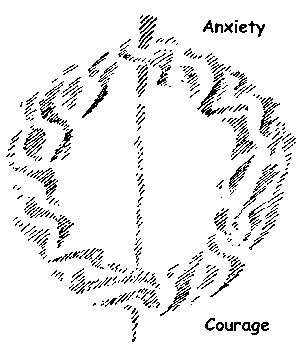
Colour, rainbow and metals
„The Earth has its origin in the spiritual. That gives a real view. And I think it is also a beautiful idea to be able to say to yourself: If you penetrate into the interior of the Earth, let the hard metals tell you what they remember, they will tell you: We were once so extended into the expanse that we were not physical substances at all, but colourfulness floating in the spirit, being, weaving in the universe. - And so the memory of the metals of the Earth is that which goes back to the state where each metal was a cosmic colour which permeated the others; where the cosmos was essentially a kind of inner rainbow, a kind of spectrum, which then differentiated itself and only became physical.
And there it is where the mere, I would like to say, theoretically communicated impression that one gets of the Earth's metallicity passes over into the moral impression. For every metal tells us at the same time: I come from the farthest reaches of space and the farthest reaches of Earth. I come from the heavenly realm, and I have been drawn together here into the interior of the Earth, conjured into it. But I await my redemption. For once again I will fill the universe with my being. - And if you learn the language of the metals, gold tells you of the Sun, lead of Saturn, copper of Venus, and then these metals tell you: As we once reached, copper to Venus, lead to Saturn, so we are enchanted here today and will again reach out there when the Earth fulfils its task, so that man may now achieve on Earth just that which he could only achieve on Earth. For that is why we entered into this enchantment, that man might become a free being on Earth. Once freedom has been bought for man, then our disenchantment can begin again.
And this disenchantment has long since been initiated in essence. One only has to understand it. One must understand how the Earth will continue to develop into the future, again with man.“ (Lit.:GA 232, p. 87f)
Building thoughts as the microcosmic equivalent of the macrocosmic rainbow
„Today you turn your gaze upwards to the rainbow. As long as it cannot be explained, it is as much a wonder of nature, a wonder of the world, as anything else. Then, out of the ordinariness of everyday life, the wonderful arch with its seven colours appears before our eyes. We now refrain from all physical explanations, because the physics of the future will have quite different things to say about the rainbow than the physics of today. We say that out there our gaze falls on the rainbow, which appears as if from the womb of the universe surrounding us. There we look into the macrocosm, into the great world. Out of it the rainbow gives birth. Now we turn our gaze a little inwards. Within ourselves we can make the observation - it is a quite everyday observation, we only have to put it in the right light - that, for example, out of thoughtless brooding, certain thoughts arise which have reference to something, that, in other words, thought flashes up in our soul. Let us take these two things: the fact of the macrocosm, that the rainbow gives birth out of the womb of the universe, and the other, that in ourselves the thought gives birth out of our other soul-life. These are two facts of which the sages of ancient Greece already knew something, and which people will learn again through spiritual science. The same forces that cause thought to flash forth in our microcosm are the forces that produce the rainbow out there in the bosom of the universe. Just as the demetic forces from outside draw into man and become effective within him, so it is the forces which form the rainbow outside out of the ingredients of nature - there they would work spread out in space - which work within us microcosmically, in the small world of man; there they cause thought to flash out of the indeterminate. Such truths, however, are not yet touched upon by external physics, yet this is indeed a truth.
Everything that is out there in space is in ourselves. Man today does not yet recognise the complete harmony of the forces working mysteriously within himself and the forces working outside in the macrocosm; indeed, he perhaps regards this as a reverie, a fantasy. The ancient Greek could not say what I have now said about these things, because he did not penetrate them with intellectual culture, but it lived in his subconscious soul-life, he saw or felt it clairvoyantly. And if we now want to express this feeling in our present modern words, we must say: The ancient Greek felt that there were working within him, for example, the forces that caused the thought to flash, and that these were the same forces that organise the rainbow out there. - He felt that. He now asked himself: If there are the soul forces inside that cause the thought to flash, then what is it outside, what is the spiritual spread in the expanse of space: above and below, right and left, in front and behind? What is there spread out in the whole space? Just as the soul-forces are within, as they flash the thought within, as they flash the rainbow outside, the morning and evening redness, the shine and glow of the clouds, - what is it out there in space? - Oh, for the ancient Greek it was a spiritual being that brought forth from the entire universal ether all these phenomena, the dawn and the dusk, the rainbow, the brilliance and light of the clouds, the lightning and thunder. And from this feeling, which, as I said, did not become intellectual knowledge, but was an elementary feeling, the view arose: this is Zeus. - And one gets no idea and still less a feeling of what the Greek soul felt as Zeus, if one does not approach this feeling and this feeling in the way of our spiritual-scientific way of looking at things. Zeus was an immediately solidly formed being, but one could not imagine it if one did not have a feeling that the forces which cause the thought to flash in us also work in the outer flash as in the rainbow and so on. But today, on anthroposophical ground, when we look into the human being and want to teach ourselves about the forces which call forth in us something like the thought, like the idea, like all that which shines and flashes forth within our consciousness, we say: All this comprises what we call the human astral body. - And there we have the microcosmic-substantial, the astral body, and we can now raise the question we have just raised in a figurative form, in a more spiritual-scientific form, and can say: Microcosmic is the astral body in us. What corresponds to the astral body in the spaces outside, what fills all spaces, right and left, front and back, above and below? - Just as the astral body is spread out in our microcosm, so are the expanses of space, so is the universal ether permeated by the macrocosmic counter-image of our astral body. And we can also say that what the ancient Greek imagined under Zeus is the macrocosmic counter-image of our astral body. The astral body is within us, it causes the appearances of consciousness to light up. Outside of us is astrality, which gives birth to rainbows, morning and evening lightning, thunder and lightning, clouds, snow and so on. The man of today has not even a word for that which the ancient Greek thought of as Zeus and which is the macrocosmic counter-image of our astral body.“ (Lit.:GA 129, p. 58ff)
The rainbow as a bridge to the spiritual world
The bridge to the otherworld, such as the Gjallar Bridge of Norse mythology or the Cinvat Bridge of Persian mythology, is often popularly imagined as a rainbow.
„In areas which have adopted even less of the newer industrial and transport culture, as in certain parts of Norway, such beautiful parts of that saga world have survived as our song by Olaf Ästeson is. It originates from ancient times, but has recently come back to life among the Norwegian people and is spreading rapidly, so that today many people know it again, after it had been lost for a long time.
It tells of a long dream which Olaf Ästeson dreams, and in which he experiences the fate of souls after death. It is based on the idea that after death the soul goes into the starry worlds, that it comes, for example, into areas where the constellations of the bull, the celestial serpent, the dog are close, that it comes into the spiritual proximity of the moon. The soul enters these worlds by crossing the Gjallar Bridge, which connects the earthly world with the spiritual one. In many folk legends the rainbow is imagined as this bridge.“ (Lit.:GA 158, p. 188)
The Warning of the Guardian of the Threshold
"As the human being beyond the threshold of being, where the Guardian stands, feels himself in the weaving, living light, it gradually, slowly, becomes not only felt light, it gradually becomes such light of which one can say: the human being sees it. From the feeling of the light, it weaves and blows, which one has, so to speak, only in the mental grasp of thought, light gradually arises which is seen as if by the spiritual eye.
But there is no other way for the human being to enter into this light - by looking - than by hearing a profound admonition from the guardian. And this warning word points to a powerful world-imagination, points to something through which man, standing here in the sense-world, can absorb into his impressions something tremendously majestic - if he has the heart for it. For when the majestic rainbow magically lights up in the sky with the appropriate clouds, then one can feel something like the spirits shining in through the rainbow's colourful glow from beyond the physical-sensual appearance. It stands there, builds itself up out of the universe, disappears again into the universe, is placed in this universe like a powerful imagination.
The guardian reminds us of this impression of the rainbow at this moment, when it is also to become bright for the seeing over there in the spiritual world. [The rainbow is drawn; see plate volume page 116. See also the note on page 202[3]].
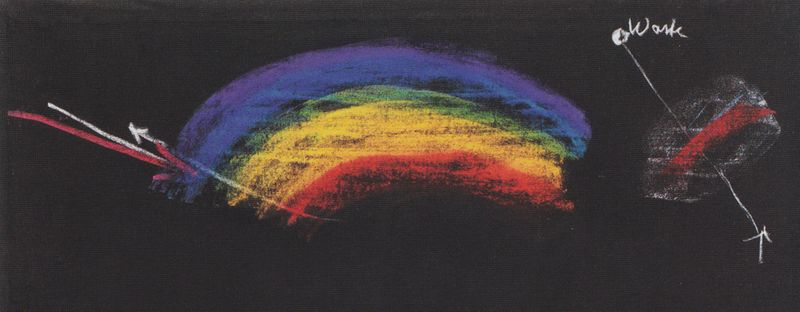
And the Guardian reminds us that the one who has thus passed over into the spiritual world, should make that image come alive in him from his memory of the sense world, which the rainbow ruling in the universe has always made for him. For it is strange, my dear sisters and brothers, that when man passes from the physical-sensuous world into the spiritual world, the image of the rainbow is that which is most easily remembered and which most easily evokes in his memory the connection between the spiritual world, in which it is now to become light, and the physical-sensuous world which he has left with his powers of knowledge.
And then - well, it is not the sight of the rainbow, it is the memory of the rainbow, which is evoked by the Guardian of the Threshold - and then the Guardian instructs one: Try now - we shall hear the words with which he speaks this - try now, with the power with which you otherwise look out of your eyes, to prepare those substances for yourself with which you penetrate this rainbow, with which you penetrate below through the rainbow to the other side.
So if we imagine [the second drawing is developed; see plate volume page 116]: In the cloud-formation inside [white] - looking up from the earth [small arrow] - the rainbow would be here [red in the cloud-formation]; so now we have to imagine: The Keeper instructs us to penetrate that rainbow and to look back from that vantage point [line through the cloud formation to the small circle on which the word "vantage point" is written] which is beyond, to look back from those expanses of worlds to the rainbow. Thus the Guardian instructs us to deepen our imagination in a meditative way if we want to proceed from the point at which we have arrived in the sense of the last hour.
Then, when we look back from over there, when you imagine, then, my sisters and brothers, that you go behind the panel [white arrow pointing to the upper left in the first drawing], look at the rainbow From backwards [red arrow pointing to the lower right in the first drawing], as it has appeared in memory, from backwards, then the rainbow becomes a mighty bowl, becomes a world bowl. And you no longer see an arch, you see a mighty bowl, half the size of the sky, and inside it the colours are flooding through one another.
That is the imagination that the guardian first arouses:
Sieh' des Äther-Farbenbogens |
See the etheric arch of colour |
[...]
One must go through such pictures. And if the picture works very intimately and deeply into the I, then the human being sees in these floods of colour which fill the bowl, as in these floods of colour the entities of the third Hierarchy appear: Angeloi, Archangeloi, Archai. And they breathe the colours, absorb the colours into their own angelic being.
One gets an idea of that world-creation which is behind the world of the senses and takes place in the deeds of the higher Hierarchies; one gets an idea of how the spiritual beings rule beyond the rainbow, first breathing in the colours of the world bowl, absorbing them into their own being. One sees how that which flows from the world to the rainbow, penetrates the rainbow, appears behind the rainbow as thoughts, how it is absorbed, breathed in by angelic beings. We now learn the nature of the rainbow. All that is thought for any region of such thoughts, which emanate from human beings, it is gathered from time to time again and again through the bridge of the rainbow, led out into the spiritual realm, where it is breathed in by the beings of the third hierarchy." (Lit.:GA 270b, p. 133ff)
See also
Literature
- Walther Bühler: Nordlicht, Blitz und Regenbogen - Metamorphosen des Lichtes, Fischer TB, Frankfurt a.M. 1982
- Rudolf Steiner: Das Johannes-Evangelium, GA 103 (1995), ISBN 3-7274-1030-2 English: rsarchive.org German: pdf pdf(2) html mobi epub archive.org
- Rudolf Steiner: Weltenwunder, Seelenprüfungen und Geistesoffenbarungen, GA 129 (1992), ISBN 3-7274-1290-9 English: rsarchive.org German: pdf pdf(2) html mobi epub archive.org
- Rudolf Steiner: Der Zusammenhang des Menschen mit der elementarischen Welt, GA 158 (1993), ISBN 3-7274-1580-0 English: rsarchive.org German: pdf pdf(2) html mobi epub archive.org
- Rudolf Steiner: Mysteriengestaltungen, GA 232 (1998), ISBN 3-7274-2321-8 English: rsarchive.org German: pdf pdf(2) html mobi epub archive.org
- Rudolf Steiner: Esoterische Unterweisungen für die erste Klasse der Freien Hochschule für Geisteswissenschaft am Goetheanum 1924, GA 270/2 (1999), ISBN 3-7274-2700-0 English: rsarchive.org German: pdf pdf(2) html mobi epub archive.org
- Rudolf Steiner: Geisteswissenschaftliche Impulse zur Entwickelung der Physik, II, GA 321 (2000), ISBN 3-7274-3210-1 English: rsarchive.org German: pdf pdf(2) html mobi epub archive.org
- Rudolf Steiner: Rhythmen im Kosmos und im Menschenwesen. Wie kommt man zum Schauen der geistigen Welt?, GA 350 (1991), ISBN 3-7274-3500-3 English: rsarchive.org German: pdf pdf(2) html mobi epub archive.org
 |
References to the work of Rudolf Steiner follow Rudolf Steiner's Collected Works (CW or GA), Rudolf Steiner Verlag, Dornach/Switzerland, unless otherwise stated.
Email: verlag@steinerverlag.com URL: www.steinerverlag.com. Index to the Complete Works of Rudolf Steiner - Aelzina Books A complete list by Volume Number and a full list of known English translations you may also find at Rudolf Steiner's Collected Works Rudolf Steiner Archive - The largest online collection of Rudolf Steiner's books, lectures and articles in English. Rudolf Steiner Audio - Recorded and Read by Dale Brunsvold steinerbooks.org - Anthroposophic Press Inc. (USA) Rudolf Steiner Handbook - Christian Karl's proven standard work for orientation in Rudolf Steiner's Collected Works for free download as PDF. |
References
- ↑ http://hyperphysics.phy-astr.gsu.edu/hbase/atmos/imgatm/lpath2.gif
- ↑ Twinned Rainbows, retrieved 22 March 2021
- ↑ For the sequence of rainbow colours given in this blackboard drawing, see GA 321, "Geisteswissenschaftliche Impulse zur Entwickelung der Physik. Zweiter naturwissenschaftlicher Kurs", 9th lecture (Lit.:GA 321, p. 143ff).
